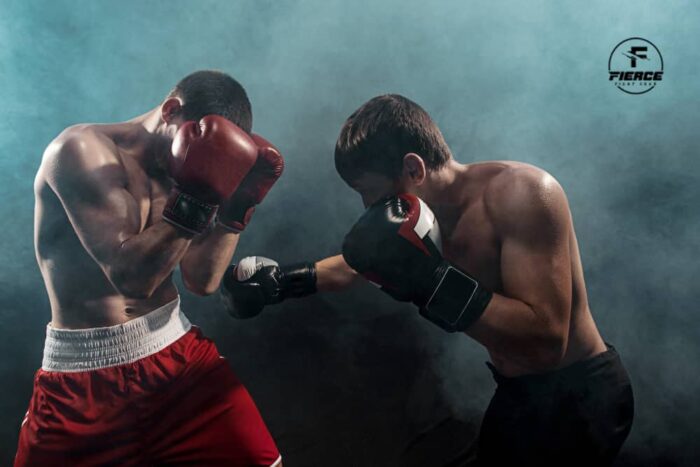Boxer vs MMA Fighter: Differences and Similarities Between MMA and Boxing
The clash between a boxer and an MMA fighter is a subject of intense fascination and debate in combat sports. The popularity of both disciplines, boxing and MMA, stems from their distinct fighting styles. Boxing is renowned for precise punches and footwork, while MMA incorporates striking, grappling, and submissions. Boxing vs MMA, which of these martial arts is better? Let’s find out now!
Boxer vs MMA: Understanding Boxing
Boxing, often referred to as the “Sweet Science,” is a combat sport that revolves around the art of using one’s fists to score points or knock out an opponent. To comprehend boxing fully, let’s break down its fundamentals, explore its essential rules and techniques, and acknowledge some of the legendary figures who have left an indelible mark on the sport.

Fundamentals of Boxing
- Boxing Rules and Regulations: Boxing matches are typically organized into rounds, with each round lasting a specific duration. Fighters score points by landing clean punches on their opponent’s head or torso. Knocking down an opponent can result in an immediate victory, as can accumulating more points over the scheduled rounds.
- Boxing Techniques: At its core, boxing revolves around a combination of offensive and defensive techniques. Fighters employ jabs, hooks, uppercuts, and crosses to land effective punches. Footwork is crucial for maneuvering in the ring, enabling fighters to control the distance and angle of engagement. Defense, including blocking, parrying, and evading, is equally vital to avoid taking unnecessary hits.
Importance of Striking, Footwork, and Defense
- Striking: Striking, represented by precise and powerful punches, is the heart of boxing. A well-executed punch can turn the tide of a match or secure a knockout victory. Boxers spend hours refining their punching techniques, honing their accuracy, timing, and speed.
- Footwork: Footwork is the foundation of a boxer’s mobility and strategy. It allows fighters to circle opponents, set up angles for attacks, and evade incoming punches. Effective footwork is a hallmark of elite boxers and plays a significant role in their success.
- Defense: Defense is as crucial as offense in boxing. A boxer’s ability to slip, bob, weave, block, and parry punches can determine their longevity in the ring. Defensive prowess minimizes damage and creates opportunities for counterattacks.
Boxer vs MMA: Understanding MMA
Mixed Martial Arts (MMA) is a combat sport that represents a departure from the singular focus of traditional martial arts disciplines. In this section, we’ll delve into the basics of MMA, its unique rules, and the incorporation of various fighting styles that make it a multifaceted and captivating sport.
Basics of MMA
- Incorporation of Various Disciplines: MMA is distinguished by its inclusive approach, allowing fighters to utilize a broad spectrum of fighting techniques. Unlike traditional martial arts, which often emphasize a specific style (e.g., Karate or Muay Thai), MMA welcomes contributions from various disciplines, including striking, grappling, and submissions.
- Rules and Regulations: MMA bouts take place within an octagonal cage or ring. Fighters can win through several methods, including knockout (striking an opponent to the point of unconsciousness), submission (forcing an opponent to concede through joint locks or chokeholds), decision (judges scoring), or technical knockout (referee intervention). Fighters must adhere to a set of rules governing fouls and conduct to ensure a fair and safe competition.
Diversity of Skills in MMA
- Striking: MMA fighters must be proficient in striking disciplines like Boxing, Muay Thai, and Kickboxing. Effective striking involves the use of punches, kicks, elbows, and knees. Striking techniques are crucial for both offensive and defensive maneuvers.
- Grappling: Grappling skills, inspired by disciplines such as Brazilian Jiu-Jitsu and Judo, play a significant role in MMA. Fighters utilize takedowns, throws, and ground control techniques to gain advantageous positions or submit opponents.
- Submissions: The art of submissions, closely associated with Brazilian Jiu-Jitsu, involves applying joint locks and chokeholds to force an opponent to tap out. This skill is essential for securing victories when the fight goes to the ground.
- Wrestling: Wrestling techniques, borrowed from the sport of wrestling, enable fighters to control their opponents’ positions and dictate the pace of the fight. Wrestlers often excel in takedowns and defensive strategies.
- Conditioning and Endurance: MMA demands exceptional conditioning and endurance due to the varied nature of fights. Fighters must be prepared for stand-up exchanges, ground battles, and transitions between the two.
MMA’s fusion of different fighting styles creates a dynamic and unpredictable environment where versatility is a prized asset. Fighters must continuously refine their skills across multiple disciplines to excel in the sport, making MMA a complex and thrilling spectacle for fans and practitioners alike.
Get the Best Boxing Gear and Equipment | Hype Up Your Game with Fierce Fight Gear
Are you getting ready to step into the ring and chase your dream of becoming a champion? Well, you’re in luck! Fierce Fight Gear has just what you need to take your Modern Martial Arts and boxing journey to a whole new level.
We’ve got all your boxing essentials covered, and the best part is, you can customize them to fit your style perfectly. Whether it’s boxing gloves that pack a powerful punch or protective gear to keep you safe, our equipment is designed to make your training better.
It doesn’t matter if you’re a seasoned boxer or just starting out; our gear is here to help you improve. Check out our collection, which includes MMA shorts for those into mixed martial arts, cool boxing jackets, gloves that perform like champs, comfy boxing shorts, and stylish boxing T-shirts. And guess what? Our gear isn’t just for boxing – it’s perfect for other combat sports like Muay Thai, Taekwondo, Kickboxing, and Karate too.
With Fierce Fight Gear, you don’t have to settle for anything less than the best. So, if you’re ready to boost your skills and confidence, start now and gear up with the finest equipment around!
Boxer vs MMA: Key Differences Between Boxing and MMA
While both boxing and Mixed Martial Arts (MMA) fall under the umbrella of combat sports, they diverge significantly in terms of rules, fighting styles, and the overall dynamics of their matches. In this section, we’ll explore the fundamental distinctions between the two sports, shedding light on what sets them apart.
Rules and Regulations
- Boxing: Boxing adheres to a set of rules designed exclusively for striking with fists. Fighters are limited to punches directed at the head and torso of their opponent. Clinching, holding, or any form of grappling is prohibited. The primary objective in boxing is to outscore the opponent through clean punches or secure a knockout.
- MMA: In contrast, MMA encompasses a broader range of techniques. Fighters can strike using fists, elbows, knees, and kicks. Additionally, they can engage in clinching, takedowns, and ground fighting, which includes grappling and submission attempts. MMA rules are more permissive in terms of techniques, resulting in a wider array of potential strategies and outcomes.
Fighting Styles
- Boxing: Boxing is solely about striking with the fists. It emphasizes precise punches, footwork, and head movement. Defensive skills are paramount, and fighters aim to outmaneuver and outscore opponents through superior boxing techniques.
- MMA: MMA incorporates striking, grappling, and submissions. Fighters are required to be versatile, with proficiency in striking (similar to boxing), takedowns, and ground control. The inclusion of submissions adds an entirely new dimension to MMA fights, as fighters can win by forcing opponents to submit.
Duration of Rounds and Pacing
- Boxing: Boxing matches typically consist of shorter rounds, usually lasting three minutes each, with brief one-minute breaks in between. The pacing is often characterized by bursts of intense action, with fighters focusing on preserving energy for the duration of the bout.
- MMA: MMA matches usually feature longer rounds, typically five minutes each, also separated by one-minute breaks. The extended round duration in MMA allows for a more varied pace, with fighters transitioning between striking, clinching, takedowns, and groundwork.
The key differences in rules, fighting styles, and round durations make boxing and MMA unique in their own right. While boxing is celebrated for its pure striking technique and strategy, MMA’s inclusivity of various fighting forms results in multifaceted and unpredictable bouts. In the following sections, we’ll explore the strengths and strategies of both boxers and MMA fighters.
Boxer vs MMA: The Strengths of a Boxer
Boxing is a discipline that places a strong emphasis on striking and precision punching. In this section, we will delve into why boxers excel in these areas, highlighting the mental toughness and conditioning required for boxing. Additionally, we’ll explore instances of boxers transitioning to MMA and the unique challenges and successes they encounter.
Striking Prowess and Precision Punching
- Technical Mastery: Boxers are renowned for their technical proficiency in striking. Years of training refine their punching techniques, resulting in precise, powerful, and accurate punches. From the quick jabs to the devastating hooks and uppercuts, boxers possess a deep understanding of how to land punches effectively.
- Footwork and Positioning: Footwork is a cornerstone of boxing, enabling fighters to control distance and angles. Boxers are skilled at positioning themselves for optimal punching opportunities while minimizing their opponent’s ability to strike back.
Mental Toughness and Conditioning
- Resilience Under Pressure: Boxing demands extraordinary mental toughness. Fighters must remain composed and focused under intense pressure, especially when they are trading punches with opponents in the heat of battle. This mental fortitude allows boxers to weather storms and stay in control of their strategy.
- Conditioning: Boxing training encompasses rigorous cardiovascular conditioning to ensure fighters have the stamina to maintain their pace throughout the duration of the match. The ability to endure multiple rounds of high-intensity action is a hallmark of a well-conditioned boxer
Boxers Transitioning to MMA
Several boxers have successfully made the transition to MMA, leveraging their striking skills to gain an advantage. Notable examples include Conor McGregor, a former boxing champion who became a two-weight UFC champion, and Holly Holm, a former professional boxer who became a UFC women’s bantamweight champion.
Note, however, that transitioning from boxing to MMA is not without its challenges. Boxers must adapt to a more comprehensive skill set, including grappling and submissions. The absence of boxing’s strict rule set, where only punches are allowed, can be a double-edged sword, as MMA fighters have a broader range of tactics at their disposal.
In summary, boxers are lauded for their striking prowess, precision punching, mental resilience, and conditioning. These attributes make them formidable competitors within the realm of combat sports. However, the transition to MMA presents a unique set of challenges, where boxers must expand their skill set to compete effectively in the multifaceted world of mixed martial arts. In the subsequent section, we will explore the strengths and strategies of MMA fighters.
Boxer vs MMA: The Strengths of an MMA Fighter
MMA fighters are known for their versatility, adaptability, and well-rounded skill sets. In this section, we will delve into the strengths of MMA fighters, emphasizing their ability to excel in grappling, striking, and submissions. We’ll also explore the importance of adaptability and share instances of MMA fighters crossing over to boxing and their experiences.

Versatility in Grappling, Striking, and Submissions:
- Grappling Proficiency: MMA fighters are skilled in various grappling techniques, including takedowns, throws, and ground control. This versatility allows them to dictate the pace of the fight, take opponents down, and avoid strikes when needed.
- Striking Diversity: MMA fighters possess a wide range of striking skills, incorporating elements of Boxing, Muay Thai, Kickboxing, and Karate. This diverse striking arsenal enables them to engage in stand-up battles effectively.
- Submissions: The ability to execute submissions, such as joint locks and chokeholds, is a unique strength of MMA fighters. They can transition from striking to grappling and leverage submissions to secure victories, even when faced with formidable strikers.
Adaptability and a Well-Rounded Skill Set
- Adaptation to Opponents: MMA fighters excel in adapting their strategies to match their opponents’ strengths and weaknesses. They can choose to engage in striking exchanges or take the fight to the ground based on the circumstances, showcasing their adaptability.
- Training Regimens: MMA fighters undergo comprehensive training that encompasses striking, grappling, and submissions. This well-rounded skill set ensures that they are prepared for a variety of scenarios in the cage.
MMA Fighters Crossing Over to Boxing
Some MMA fighters have successfully crossed over to boxing, demonstrating their adaptability. Conor McGregor, for instance, transitioned from MMA to boxing for a high-profile bout against Floyd Mayweather Jr. While he didn’t secure a victory, his performance highlighted the capabilities of MMA fighters in the realm of boxing.The transition to boxing can be a valuable learning experience for MMA fighters, as it exposes them to a different set of techniques and tactics. It also allows them to test their skills against elite boxers.
In summary, MMA fighters’ strengths lie in their versatility across grappling, striking, and submissions, their adaptability to diverse opponents, and their commitment to a well-rounded skill set. While they excel in their domain, some MMA fighters have ventured into boxing, showcasing their ability to adapt and compete effectively in a different combat sport.
Frequently Asked Questions
The preference between MMA and boxing varies based on personal taste. Boxing is known for precise striking, footwork, and defense, ideal for those who enjoy one-on-one battles. MMA offers a broader experience with striking, grappling, and submissions, appealing to those who prefer diverse combat styles.
The outcome depends on factors like the MMA fighter’s skills, the bodybuilder’s size, and the contest rules. In regulated MMA, a skilled fighter with a diverse skill set would likely win. MMA requires more than just strength.
Both are tough but in different ways. Boxing demands precision, cardio, and mental toughness. MMA is complex due to its diverse skills, including striking and grappling. It depends on your preference for diversity or pure striking
The result hinges on the boxer’s skill, the bodybuilder’s strength, and the contest rules. A skilled boxer would likely win in standard boxing rules. Boxing isn’t just about strength; it requires technique and strategy.
